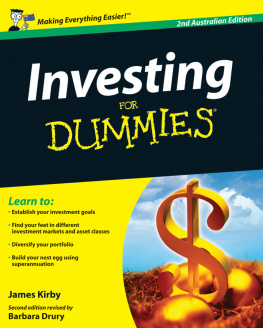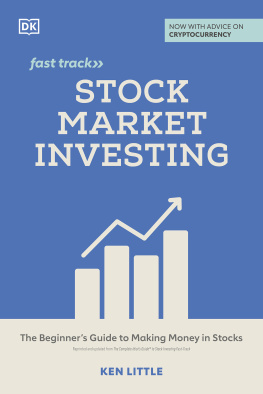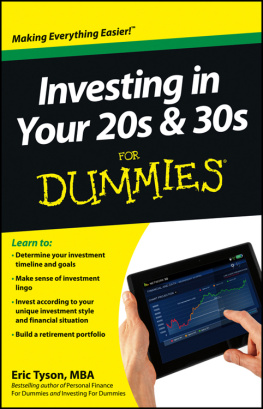More Praise for The 3 Simple Rules of Investing
This is the book that investors have needed for a long time. It empowers readers to take control of their financial lives and to tune out the propaganda from the investment industry. It becomes easy for investors to do the right things for themselves once they get rid of all the noise and follow the simple approach that the book recommends.
Joseph Tomlinson, actuary and financial planner
In the world of high finance and investment, in which the top 0.01 percent and the wannabes who work for them are out to make lots more money with your money, without giving a hoot about your interests, this is one of the few books that we nonexperts on such matters can trust to get us started.
Bill Domhoff, Professor Emeritus of Sociology, University of California, Santa Cruz
This very practical book by four expert insiders cuts through all the nonsense and reduces successful investing to a few commonsense principles. It can help you and everybody elseexcept, perhaps, the huge financial industry that generates lavish profits by misleading millions of investors.
Richard C. J. Somerville, PhD, Professor Emeritus and Research Professor, Scripps Institution of Oceanography, University of California, San Diego
THE 3 SIMPLE RULES OF INVESTING
THE 3 SIMPLE RULES OF INVESTING
WHY EVERYTHING YOUVE HEARD
ABOUT INVESTING IS WRONG
AND WHAT TO DO INSTEAD
Michael Edesess Kwok L. Tsui
Carol Fabbri George Peacock

The 3 Simple Rules of Investing
Copyright 2014 by Three Rules LLC
All rights reserved. No part of this publication may be reproduced, distributed, or transmitted in any form or by any means, including photocopying, recording, or other electronic or mechanical methods, without the prior written permission of the publisher, except in the case of brief quotations embodied in critical reviews and certain other noncommercial uses permitted by copyright law. For permission requests, write to the publisher, addressed Attention: Permissions Coordinator, at the address below.

| Berrett-Koehler Publishers, Inc.
235 Montgomery Street, Suite 650
San Francisco, California 94104-2916
Tel: (415) 288-0260, Fax: (415) 362-2512
www.bkconnection.com |
Ordering information for print editions
Quantity sales. Special discounts are available on quantity purchases by corporations, associations, and others. For details, contact the Special Sales Department at the Berrett-Koehler address above.
Individual sales. Berrett-Koehler publications are available through most bookstores. They can also be ordered directly from Berrett-Koehler: Tel: (800) 929-2929; Fax: (802) 864-7626; www.bkconnection.com
Orders for college textbook/course adoption use.
Please contact Berrett-Koehler: Tel: (800) 929-2929; Fax: (802) 864-7626.
Orders by U.S. trade bookstores and wholesalers. Please contact Ingram Publisher Services, Tel: (800) 509-4887; Fax: (800) 838-1149; E-mail: customer.service@ingrampublisherservices.com; or visit www.ingrampublisherservices.com/Ordering for details about electronic ordering.
Berrett-Koehler and the BK logo are registered trademarks of Berrett-Koehler Publishers, Inc.
First Edition
Paperback print edition ISBN 978-1-62656-162-5
PDF e-book ISBN 978-1-62656-163-2
IDPF e-book ISBN 978-1-62656-164-9
2014-1
Production Management: Michael Bass Associates
Cover Design: Dan Tesser/Pemastudio
To our daughters, sons, and spouses:
Hilary, Ariel, Joshua, Matthew,
Suklai, Alex, Luca, Duncan, June,
Hayley, and Mackenzie
CONTENTS
PREFACE
We wrote this book for all sorts of investors, from novice to experienced professional, because all of us knewindependently and at different timesthat something was very wrong with the financial services industry (or simply financial industry, in this book), especially its fastest-growing sector: the securities sector and its huge investment management and advisory services arm. We wanted to explain this problem and then offer an easy-to-use solution.
Michael made an important discovery almost immediately after receiving a degree from MIT and a PhD in mathematics from Northwestern, when he joined a brokerage firm known for its use of sophisticated mathematics. He found that although the firms representatives spoke to clients in a language laden with mathematical terms (e.g., This fund has a low beta but its alpha is high; The portfolio has the highest expected return for its standard deviation), they actually knew nothing about the mathematics and the mysterious formulas and algorithms behind their statements.
Kwok, a professor and renowned statistician whose career spanned roles at Bell Labs and several universities, knew that almost all claims of beating the market arose from practices that statisticians recognize as unprofessional and downright wrong. For example, investment firms often boast about strong returns on their investment productsmutual funds and suchin their marketing materials. If you were to read the fine print in these documents, you might uncover the data supporting these claims. What Kwok recognized, however, is that many firms do what statisticians call cherry-picking: selecting from a vast body of data only those data points that back up the desired claims, and ignoring the mountain of research that disproves those claims. In other words, investment firms typically reveal only what they want investors to see.
Carol became a financial advisor following an MBA from MITs Sloan School of Management and a successful career in management consulting. While working for a large brokerage firm, Carol grew dissatisfied with the direct and indirect fees that the firm charged her clients, and with the lack of a formal responsibility to act in the clients best interest. Today she continues to see complicated descriptions, fancy terminology, and opaque fee structures mislead hardworking investors, who are tirelessly saving to achieve their dreams.
George was a liberal arts major at Georgetown University who became a financial advisor. He naturally assumed that the methodologies that the industry and his employers promoted were correct. But gradually, over a 20-year period working for several of the best-respected financial firms, he began to realize that most of the foundational assumptions and best practices didnt make sense. For example, increasingly over time, every firm he worked for made a key sales point out of the fact that they would optimize a clients portfolio by running a scientific asset allocation; but actually the process was nothing but GIGO: garbage in and garbage out.
Collectively, we authors have concluded that by honing marketing pitches, the financial industry has created a false framework of concepts that it conveys to clients and sells to prospects. With only a few notable exceptions, the confusing proliferation of investment services and products is of no value to any investor. A minuscule subset of the investment products and advice availablethe simplest and least costly onesare all that an investor really needs. To opt for the more complex or confusing investment vehicles and advice is merely to pay a lot for nothing.
Next page






